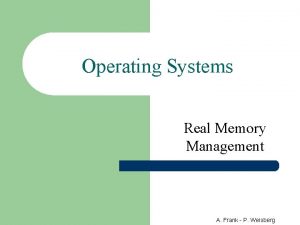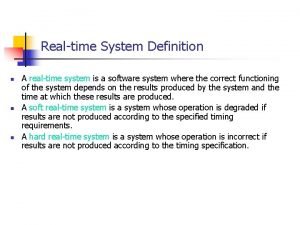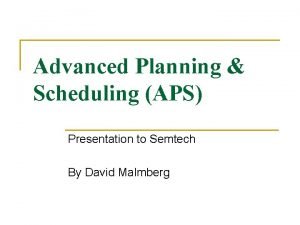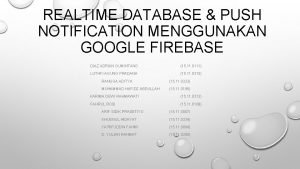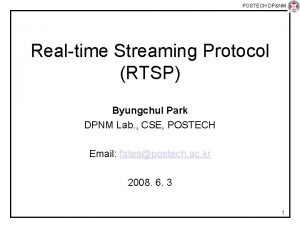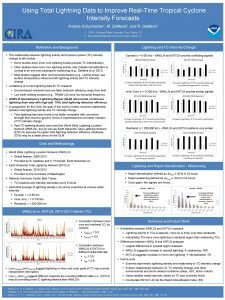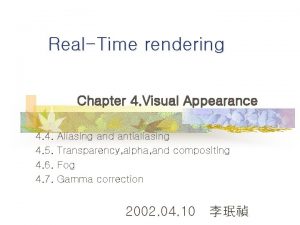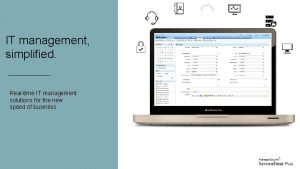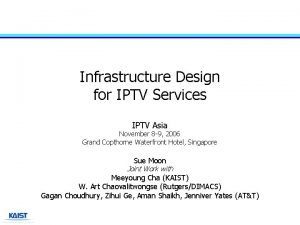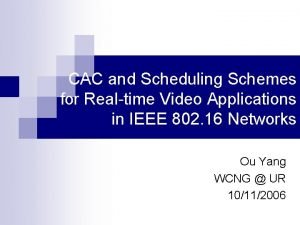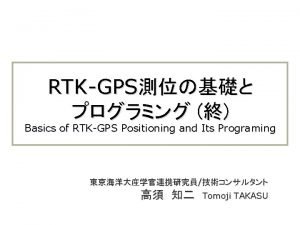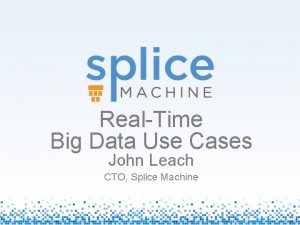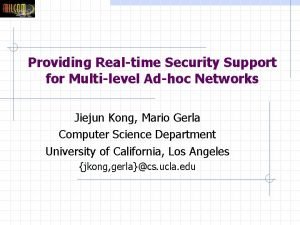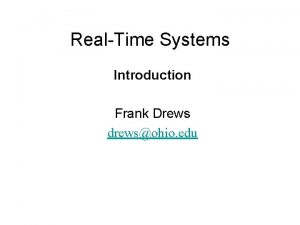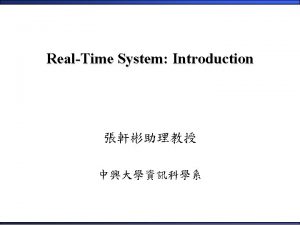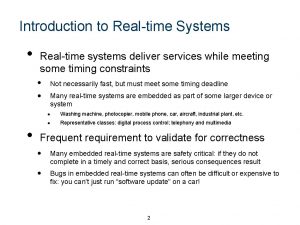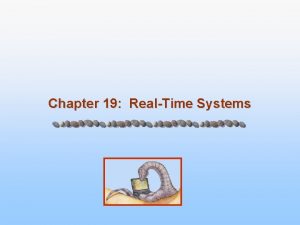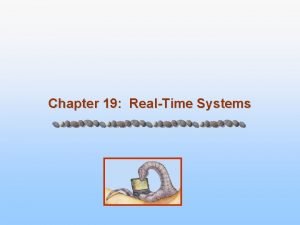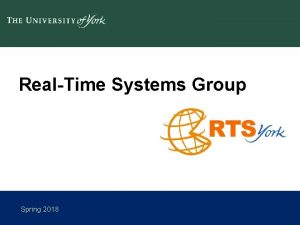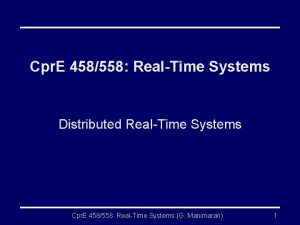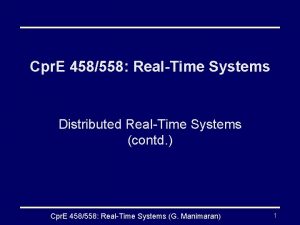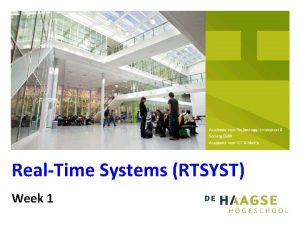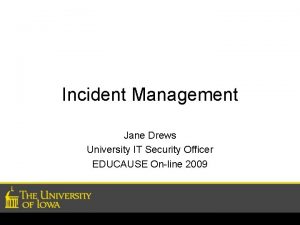RealTime Systems Introduction Frank Drews drewsohio edu Frank


![Embedded Systems • [www. webopedia. com]: An embedded system is “a specialized computer system Embedded Systems • [www. webopedia. com]: An embedded system is “a specialized computer system](https://slidetodoc.com/presentation_image_h/c6d78ec0eea8727907683117788f8a0f/image-3.jpg)












![Air Traffic Control [Reddaway et al. WMPP’ 05] Frank Drews Real-Time Systems Introduction - Air Traffic Control [Reddaway et al. WMPP’ 05] Frank Drews Real-Time Systems Introduction -](https://slidetodoc.com/presentation_image_h/c6d78ec0eea8727907683117788f8a0f/image-16.jpg)














- Slides: 30

Real-Time Systems Introduction Frank Drews drews@ohio. edu Frank Drews Real-Time Systems Introduction - 1

Real-time Systems • A real-time system is a system whose specification includes both logical and temporal correctness requirements. • Logical Correctness: Produces correct outputs. – Can by checked, for example, by Hoare logic. • Temporal Correctness: Produces outputs at the right time. – In this course, we spend much time on techniques and technologies for achieving and checking temporal correctness. Frank Drews Real-Time Systems Introduction - 2
![Embedded Systems www webopedia com An embedded system is a specialized computer system Embedded Systems • [www. webopedia. com]: An embedded system is “a specialized computer system](https://slidetodoc.com/presentation_image_h/c6d78ec0eea8727907683117788f8a0f/image-3.jpg)
Embedded Systems • [www. webopedia. com]: An embedded system is “a specialized computer system that is part of a larger system or machine. Typically, an embedded system is housed on a single microprocessor board with the programs stored in ROM. Virtually all appliances that have digital interfaces (e. g. , watches, microwaves, VCRs, cars) utilize embedded systems […]” • Many embedded systems are real-time systems Frank Drews Real-Time Systems Introduction - 3

Typical Characteristics of Real. Time Systems • • • Event-driven, reactive. High cost of failure. Concurrency/multiprogramming. Stand-alone/continuous operation. Reliability/fault-tolerance requirements. Predictable behavior. Frank Drews Real-Time Systems Introduction - 4

Misconceptions about Real-Time Systems (Stankovic ‘ 88) • There is no science in real-time-system design. – We shall see… • Advances in supercomputing hardware will take care of real-time requirements. – The old “buy a faster processor” argument… • Real-time computing is equivalent to fast computing. – Only to ad agencies. To us, it means PREDICTABLE computing. Frank Drews Real-Time Systems Introduction - 5

Misconceptions (Continued) • Real-time programming is assembly coding, – We would like to automate (as much as possible) real-time system design, instead of relying on clever hand-crafted code. • “Real time” is performance engineering. – In real-time computing, timeliness is almost always more important than raw performance … • “Real-time problems” have all been solved in other areas of CS or operations research. – OR people typically use stochastic queuing models or one-shot scheduling models to reason about systems. – In other CS areas, people are usually interested in optimizing average-case performance. Frank Drews Real-Time Systems Introduction - 6

Misconceptions (Continued) • It is not meaningful to talk about guaranteeing real-time performance when things can fail. – Though things may fail, we certainly don’t want the operating system to be the weakest link! • Real-time systems function only in a static environment. – Note true. We consider systems in which the environment may change dynamically. Frank Drews Real-Time Systems Introduction - 7

Are All Systems Real-Time Systems? • Question: Is a payroll processing system a realtime system? – It has a time constraint: Print the pay checks every two weeks. • Perhaps it is a real-time system in a definitional sense, but it doesn’t pay us to view it as such. • We are interested in systems for which it is not a priori obvious how to meet timing constraints Frank Drews Real-Time Systems Introduction - 8

The “Window of Scarcity” Resources may be categorized as: • Abundant: Virtually any system design methodology can be used to realize the timing requirements of the application. • Insufficient: The application is ahead of the technology curve; no design methodology can be used to realize the timing requirements of the application. • Sufficient but scarce: It is possible to realize the timing requirements of the application, but careful resource allocation is required. Frank Drews Real-Time Systems Introduction - 9

Example: Interactive/Multimedia Applications Frank Drews Real-Time Systems Introduction - 10

Example: Real-Time Applications Many real-time systems are control systems Example 1: A simple one-sensor, oneactuator control system Frank Drews Real-Time Systems Introduction - 11

Simple Control System (Continued) Pseudo-code for this system: T is called sampling period. T is a key design choice. Typical range for T: seconds to milliseconds. Frank Drews Real-Time Systems Introduction - 12

Time Frank Drews Real-Time Systems Introduction - 13

Multi-rate Control Systems More complicated control systems have multiple sensors and actuators and must support control loops of different rates. Example 2: Helicopter flight controller. Note: Having only harmonic rates simplifies the system Frank Drews Real-Time Systems Introduction - 14

Hierarchical Control Systems Frank Drews Real-Time Systems Introduction - 15
![Air Traffic Control Reddaway et al WMPP 05 Frank Drews RealTime Systems Introduction Air Traffic Control [Reddaway et al. WMPP’ 05] Frank Drews Real-Time Systems Introduction -](https://slidetodoc.com/presentation_image_h/c6d78ec0eea8727907683117788f8a0f/image-16.jpg)
Air Traffic Control [Reddaway et al. WMPP’ 05] Frank Drews Real-Time Systems Introduction - 16

Signal-Processing System • Signal-processing systems transform data from one form to another. • Examples: – Digital filtering. – Video and voice compression/decompression. – Radar signal processing. • Response times range from a few milliseconds to a few seconds. Frank Drews Real-Time Systems Introduction - 17

Example: Radar System Frank Drews Real-Time Systems Introduction - 18

Internet/Multimedia Applications • Web farms hosting multiple web domains static dynamic streaming content video/audio – Each web domain receives a certain share of the overall resources (CPU, network, file system) – Each web domain consists of an application pool (static content, dynamic content, streaming video/audio, etc. ) • Challenges – Sharing the resource among domains (i. e. application pools) may be hard in general purpose Operating Systems – Guarantee of a uniform, steady, jitterfree execution of time critical multimedia applications while not starving other applications – Support of multiprocessor server systems Frank Drews Real-Time Systems Server Domain 1 Domain 3 Domain 2 Introduction - 19

Other Real-Time Applications • Real-time databases. – Transactions must complete by deadlines. – Main dilemma: Transaction scheduling algorithms and real-time scheduling algorithms often have conflicting goals. – Data may be subject to absolute and relative temporal consistency requirements. – Overall goal: reliable responses • Multimedia. • Want to process audio and video frames at steady rates. – TV video rate is 30 frames/sec. HDTV is 60 frames/sec. – Telephone audio is 16 Kbits/sec. CD audio is 128 Kbits/sec. • Other requirements: Lip synchronization, low jitter, low end-to-end response times (if interactive). Frank Drews Real-Time Systems Introduction - 20

Hard vs. Soft Real Time • Task: A sequential piece of code. • Job: Instance of a task • Jobs require resources to execute. – Example resources: CPU, network, disk, critical section. – We will simply call hardware resources “processors”. • Release time of a job: The time instant the job becomes ready to execute. • Deadline of a job: The time instant by which the job must complete execution. • Relative deadline of a job: “Deadline - Release time”. • Response time of a job: “Completion time - Release time”. Frank Drews Real-Time Systems Introduction - 21

Example Job is released at time 3. It’s absolute deadline is at time 10. It’s relative deadline is 7. It’s response time is 6. Frank Drews Real-Time Systems Introduction - 22

Hard Real-Time Systems • A hard deadline must be met. – If any hard deadline is ever missed, then the system is incorrect. – Requires a means for validating that deadlines are met. • Hard real-time system: A real-time system in • which all deadlines are hard. – We consider hard and soft real-time systems in this course. • Examples: Nuclear power plant control, flight control. Frank Drews Real-Time Systems Introduction - 23

Soft Real-Time Systems • A soft deadline may occasionally be missed. – Question: How to define “occasionally”? • Soft real-time system: A real-time system in which some deadlines are soft. • Examples: multimedia applications. Frank Drews Real-Time Systems Introduction - 24

Performance • Two particular factors are important – How fast does a system respond – When it fails, what happens? Frank Drews Real-Time Systems Introduction - 25

The Speed of Response • All required responses are time-critical – The designer should predict the delivered performance of the systems with the required performance – Unfortunately, it may not be possible to give 100% guarantees Frank Drews Real-Time Systems Introduction - 26

Periodic vs. Aperiodic Tasks • Periodic Tasks – Tasks run at regular, pre-defined intervals – Example: closed loop digital controller having fixed, pre-set sampling rates Execute control task Idle time Sampling interval t 0 Frank Drews t 1 Synchronous real-time clock signals Real-Time Systems t 2 Introduction - 27

Periodic vs. Aperiodic Tasks • Aperiodic Tasks – Occur when the computer must respond to (generally) external events which occur at random (asynchronous or aperiodic); have either soft or no deadlines • Sporadic Tasks – Similar to aperiodic tasks; however, the event must be serviced within a specific maximum time period; hard deadline Execute event task e 0 Frank Drews Idle time Execute event task Idle time e 1 Asynchronous events Real-Time Systems time e 2 Introduction - 28

Mixing Periodic and Aperiodic Tasks • We get into trouble in situations which involve a mix of periodic and aperiodic(sporadic) events, which are usual in real-time designs • Much thought and skill are needed to deal with the response requirements of periodic and aperiodic tasks Frank Drews Real-Time Systems Introduction - 29

Real-Time Operating Systems (RTOSs) • RTOS: specialized operating system for RTS • Main responsibilities: – Process management – Resource allocation (processor, memory, network) • They may not include regular OS facilities such as file management, virtual memory, user/kernel level separation, etc. • Manage at least two priority levels: – Interrupt level, for processes that need fast response – Clock level, for periodic processes • Typical components: real-time clock, interrupt handler, scheduler, resource manager, dispatcher Frank Drews Real-Time Systems Introduction - 30
 Frank drews
Frank drews Dr. frank drews
Dr. frank drews Frank drews
Frank drews Frank drews
Frank drews Drews scriptorama
Drews scriptorama Konopinska drews hannover
Konopinska drews hannover Amanda drews
Amanda drews Edu.sharif.edu
Edu.sharif.edu Realtime system
Realtime system Gullistan carpet
Gullistan carpet Firebase realtime database push notification
Firebase realtime database push notification Realtime streaming protocol
Realtime streaming protocol Curis realtime
Curis realtime The forrester wave real time interaction management q2 2017
The forrester wave real time interaction management q2 2017 Lightning realtime
Lightning realtime Simple online and realtime tracking
Simple online and realtime tracking Visual rendering
Visual rendering Real time operating system concepts
Real time operating system concepts Realtime communications
Realtime communications Realtime it
Realtime it Realtime it
Realtime it Realtime it
Realtime it Iptv infrastructure
Iptv infrastructure Cac realtime
Cac realtime Realtime forex
Realtime forex Okolm
Okolm Rendering realtime compositing
Rendering realtime compositing Realtime big data
Realtime big data Ad hoc realtime
Ad hoc realtime Rational rose
Rational rose Ams realtime weather maps central
Ams realtime weather maps central



